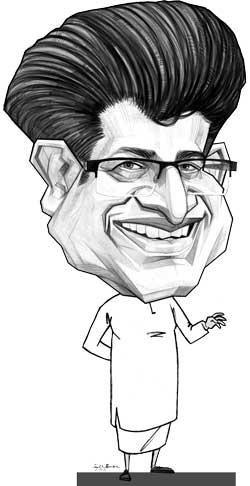08 Oct 2020 - {{hitsCtrl.values.hits}}
 Energy Minister Udaya Gammanpila spoke to Daily Mirror about the oil and gas policy of Sri Lanka and the potential for offshore gas extraction. The minister is confident that Sri Lanka will become an oil and gas-producing nation. Experts from the interview:
Energy Minister Udaya Gammanpila spoke to Daily Mirror about the oil and gas policy of Sri Lanka and the potential for offshore gas extraction. The minister is confident that Sri Lanka will become an oil and gas-producing nation. Experts from the interview:
What are your plans for the development of the energy sector?
First, the president assigned the Energy Ministry to me. I don’t have any state or deputy minister for me. That is to give an absolute free hand. He wants me to achieve a crucial goal of the nation. That is discovery of oil and gas resources in our territory.

First, it was only a logical conclusion. India has oil and gas in its sea bordering Sri Lanka. That may be the case for Sri Lanka because nature does not recognise the man-made boundaries. I have a task to produce our own gas and oil.
Offshore oil and gas exploration has been a topic discussed for a long time. Earlier, TGS- NOPEC, a Norwegian company, was involved. Later, Cairn India did some work. Still, we have not been able to harness the potential.
Why is it?
Frankly, the story goes beyond the Norwegian survey. In 1976, Prime Minister, the late Sirimawo Bandaranaike, announced that Sri Lanka had oil resources. There was more talk but less work.
What are the actual scientific findings?
When Cairn dug four wells, it was able to find gas in two of them. The world norm is discovering oil in one out of seven wells dug. In Sri Lanka, it is two out of four or 50 percent. Norwegians had to dig 31 wells to discover oil.
When you take international standards into account, the potential of producing commercially viable oil and gas in Sri Lanka is very high. If it is so, why did not the big players in the industry get attracted to bidding in 2007 and 2012?
First, there was logical conclusion that we might have oil and gas since India has them on the border. Now, it has been proven that at least gas is available here. Our assessment is these gas deposits are sufficient to meet the Sri Lankan requirements for 30 years. Secondly, Sri Lanka did not have an oil or gas policy. That is very much crucial in attracting big investments. Without having a concrete policy, nobody will invest billions of dollars for anything. Thirdly, this is a business. There must be a flexible, commercial arm for them to deal with. The present institution is the Petroleum Resource Development Secretariat, consisting exclusively of government bureaucrats.
In this backdrop, I submitted a natural gas policy to the Cabinet for approval. I received the Cabinet nod. Secondly, I will introduce a bill to set up a council, which has energy experts, financial experts and legal experts, in addition to bureaucrats. Thirdly, we are in the process of drafting a new bill to regulate the oil and gas industry. After completing these three steps, we will go for international bidding. I am very much confident that all big players will participate in it.
How soon will it take for you to present it?
I cannot fix you an exact date. I make a pledge to the nation that I will come before people next time, after adding Sri Lanka to the list of oil and gas-producing nations.
When we join that club of nations, it can trigger some geopolitical concerns. We can become a geopolitical hotspot because there are big powers such as India and China interested in the region. What are your plans to stand up to such a possible scenario?
I have already met the Indian high commissioner and Chinese ambassador several times. I understand their economic and national security concerns. I am ready to accommodate them without jeopardising our economic and national security interests.
We have already commenced negotiations with India to take back some of the oil tanks leased out from the oil tank farm in Trincomalee. They have been leased out since 2003. I am confident that India would be flexible and understand that Sri Lanka should place Sri Lanka first.
What are the plans for development of them?
There are 99 tanks. They use only 15 tanks. In other words, Sri Lanka has an energy security issue since we don’t have adequate storage capacity. We have two issues. If one or two ships are delayed, there will be a fuel shortage. We experienced it twice during the term of the last government.
Secondly, when we have extended storage capacity, we can maximally exploit the advantage of price drops in the world market. Whenever the prices drop, we can make spot purchases to be stored. I have already obtained the Cabinet approval to expand the storage capacity at Kolonnawa by 21000 cubic metres. We built three banks to meet that requirement.
We have another big issue. Pipelines that convey oil from ships to Kolonnawa and Sapugaskanda are 48 to 75 years old. As a result, there are a lot of leakages. In the end, the cost of such leakages would be added to the price and people pay a premium price for the government’s negligence and inefficiency. Hence, I want to build three pipelines as early as possible. We have already initiated the required designs.
Fourthly, our refinery is 56 years old. It was upgraded in 1972. Hence, the oil produced by us at Sapugaskanda does not meet international standards. The world is moving towards the EURO 5 standards to minimise pollution. But we can produce only EURO 2. Therefore, upgrading the refinery is the next priority.
Fifthly, at the moment, we produce only 20 percent of the petrol requirement and 25 percent of the diesel requirement. Because of that, we waste our hard-earned foreign currency to import refine fuel. Therefore, we want to build three refineries at Trincomalee, Hambantota and somewhere near Colombo.
There are several advantages of doing it. First, the distribution cost will come down since these refineries can look after local areas. For instance, we have to transport oil from Kolonnawa to Kankesanthurai. When we have a refinery and storage capacity in Trincomalee, it can look after the Northern, North-Central and Eastern provinces. The Hambantota oil refinery will look after the Uva, Sabaragamuwa and Southern provinces. The Colombo one will look after the rest.
Sixthly, I have decided to change the transport mode for fuel. During the British time, they built regional oil storage facilities near railway stations, enabling transportation of oil by rail. If we do that, we can reduce the cost, minimise pollution and traffic congestion.
Unfortunately, we have given up something good done by our former colonial masters. If we use railway tracks from 10:00 p.m. to 4:00 a.m. to transport oil, the railway authorities will have additional income, in addition to the three benefits mentioned by me before.
When Indian Prime Minister Narendra Modi visited Sri Lanka in 2015 and addressed Parliament, he talked of the development of Trincomalee as a petroleum hub. Is this going to be a joint venture?
My ultimate aim is to make Sri Lanka the energy hub of Asia. Sri Lanka should have been the energy hub. Since we did not exploit the advantage of our geographical location, Singapore grabbed that opportunity. Singapore’s one main export product is oil though it does not produce even a single drop of oil.
Sri Lanka can easily develop as the energy hub using the Hambantota and Trincomalee ports. Because of the shallow nature of the Palk Strait, Indian ships navigating between the eastern and western coats have to go around Sri Lanka.
We can refuel those ships in Trincomalee. The ships which are going towards the Far East – China, South Korea and Japan, etc. – can be refuelled in Hambantota. Both the Trincomalee and Hambantota ports can play a vital role to develop Sri Lanka as the energy hub of Asia.
22 Nov 2024 22 Nov 2024
22 Nov 2024 22 Nov 2024
22 Nov 2024 22 Nov 2024
22 Nov 2024 22 Nov 2024
22 Nov 2024 22 Nov 2024